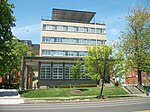Statue of Christopher Columbus (Buffalo, New York)
Buildings and structures in Buffalo, New YorkMonuments and memorials in New York (state)Monuments and memorials to Christopher ColumbusNew York (state) sculpture stubsOutdoor sculptures in New York (state) ... and 5 more
Sculptures of men in New York (state)Statues in New York (state)Statues of Christopher ColumbusStatues removed in 2020Vandalized works of art in New York (state)

A statue of Christopher Columbus by the sculptor Giovanni Polizzi formerly stood in Columbus Park, in Buffalo, New York.
Excerpt from the Wikipedia article Statue of Christopher Columbus (Buffalo, New York) (License: CC BY-SA 3.0, Authors, Images).Statue of Christopher Columbus (Buffalo, New York)
Porter Avenue, Buffalo
Geographical coordinates (GPS) Address Nearby Places Show on map
Geographical coordinates (GPS)
| Latitude | Longitude |
|---|---|
| N 42.901222222222 ° | E -78.892944444444 ° |
Address
Porter Avenue 245
14201 Buffalo
New York, United States
Open on Google Maps








